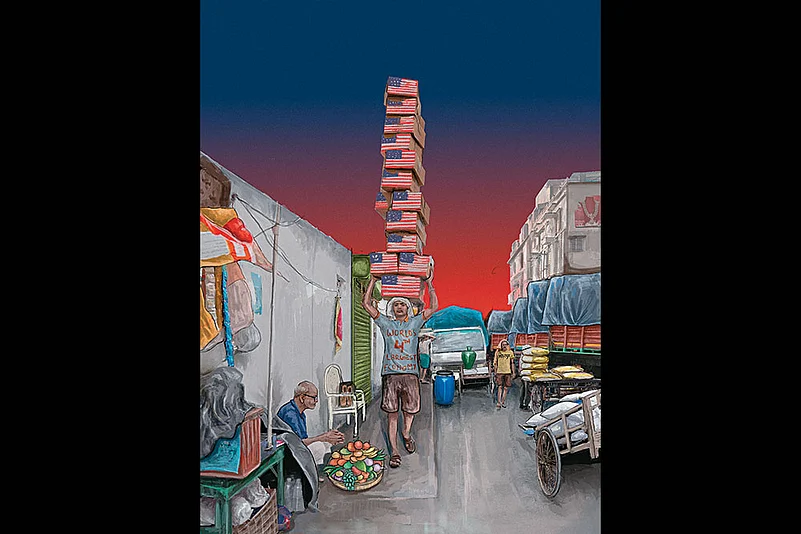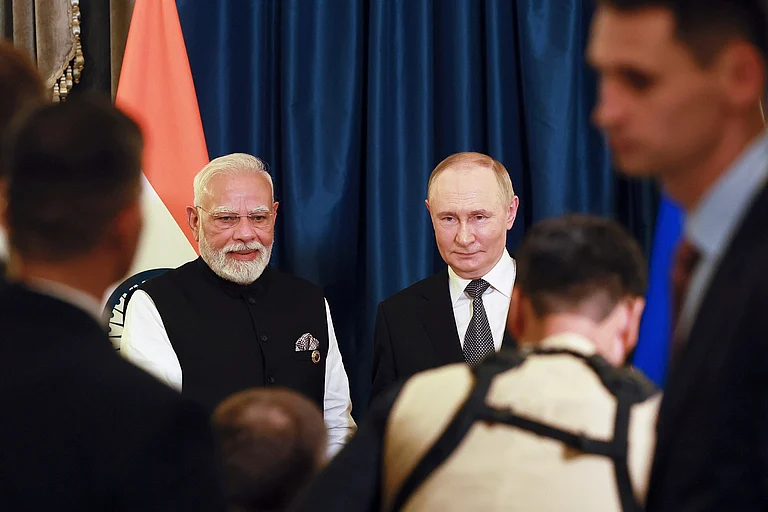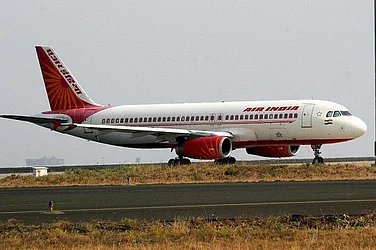
Trump’s bullying of India appears to have a strong personal element.
He has been needlessly insulting India, calling it a dead economy.
India's economy has shock absorbers, but perhaps not strong for 50 per cent tariffs.
Donald Trump has given body blows to India-US ties quite gratuitously. The growth in ties after the 2005 nuclear deal under three different presidents, whether Republican or Democratic, was based on a serious evaluation of the importance of these ties at both the bilateral and geopolitical levels.
In the process, the US became India’s biggest trade and investment partner, defence ties expanded, export controls of advanced equipment and technologies were progressively eased for India, the Initiative for Critical and Emerging Technologies chaired by the National Security Advisers on both sides was launched. Space cooperation was given a boost.
The Quad was formed to deter Chinese expansionism in the western Pacific and the Indian Ocean. The Indo-Pacific concept emerged, which linked the security of the Pacific and the Indian Oceans. This led to the US renaming the Pacific Command as the Indo-Pacific Command.
All this showed that the basis of a long-term relationship based on shared interests and growing trust was being laid. The US began defining the strategic partnership with India as the defining relationship of the 21st century. Trump has, however, lost that focus.
During his first presidency, he and Narendra Modi forged a close personal rapport. The expectation was that despite Trump’s mercurial nature and his obsession with high Indian tariffs, we were optimistic about managing the relationship well enough during his second term. India made a remarkable start, with Trump receiving Modi at the White House in February, within a few weeks of his inauguration. The two sides were able to produce a very substantial joint statement that included all the key initiatives, especially on the technology side, launched under the Joe Biden presidency. It was agreed that the two sides will work on an interim deal on trade and will negotiate a multi-sectoral trade agreement by autumn to be signed when Trump comes to India for the Quad summit.
The interim deal was intended to take the heat off the tariff issue, which had become central to Trump’s foreign policy. He went ahead to announce tariffs on virtually the entire world on no discernible rational basis, with India subject to 27 per cent. He was totally unconcerned that he was violating the World Trade Organization (WTO) rules and was weaponising tariffs. He gave timelines as effective ultimatums for other countries to propose lowering their tariffs to allow the US to decide the final tariff figure on their exports to the US. This was his Art of the Deal, his strategy to escalate and de-escalate.
The India-US interim deal was intended to be concluded before Trump’s timeline, with five rounds of serious negotiations during which India made substantive concessions, resulting in a text that the United States Trade Representative (USTR) apparently found acceptable. Trump has chosen not to approve this text as he wants the full opening or almost the full opening of the Indian market. Having browbeaten the European Union (EU) and Japan to agree to a very one-sided deal, Trump may have felt that he could browbeat India too, especially on prising open the agriculture and dairy sectors, which are red lines for India.
Without waiting for more talks, as in China’s case, Trump has gone ahead and announced a 25 per cent tariff on India, the highest amongst the Asian economies. He has even more provocatively gone beyond the trade issue to impose a penalty of an additional 25 per cent tariff for India’s purchases of Russian oil and defence equipment. He has revived the Biden era pressures on India to cease buying oil and reduce defence ties with Russia after it intervened militarily in Ukraine. India had firmly pushed back then and the Biden administration ceased making it an issue in recognition of the imperatives of its geopolitical priorities in Asia, which Trump is ignoring.
Trump’s penalty is an attempt to limit India’s freedom to pursue an independent foreign policy in the light of its vital national interests. Russian oil is not sanctioned. Even though the price cap on Russian oil has no legality, India is buying Russian oil within the cap. And that too, as we have said officially, with the encouragement of the US to maintain stability in global oil prices because with the Russian oil excluded from the market, the international price of oil could have shot up dramatically and hurt even the American consumer.
Trump’s bullying of India has a strong personal element. He has been needlessly insulting India, calling it a dead economy. With his obsession to be seen as a peacemaker and craving for a Nobel Peace prize to vie with Barack Obama, Trump has now claimed 28 times that he brokered the ceasefire between India and Pakistan during Operation Sindoor by wielding the trade threat, irked, no doubt, by India’s official denials. Trump gave no consideration to the fact that his self-publicising claims were putting Modi in a difficult political position as they implied that either he sought US intercession or buckled under US pressure. We have seen how this issue has played out in the Indian Parliament.
By praising the Pakistani leadership soon after the Pahalgam attack, inviting the Pakistani army chief with his Islamist Hindu-hating leanings to the White House for lunch in an unprecedented move, reviving the Kashmir issue by proposing mediation on Kashmir, seeking to invite Modi to Washington from Canada (where he was attending the G7 meeting) while he was entertaining the Pakistani army chief, Trump has showed acute insensitivity towards India. A crypto deal with Pakistan facilitated by the country’s army chief, in which those around Trump have financial interest, and deals offered to exploit Pakistan’s mineral and oil resources seem to have lubricated Trump’s softness towards Pakistan.
Trump’s Treasury Secretary Scott Bessent has threatened India with even higher tariff penalties if the Alaska talks between Trump and Putin fail. (These talks seem to have ended with limited progress and no announcement of a ceasefire. The scene has shifted to Washington D.C. with Trump holding talks with Volodymyr Zelenskyy and key European leaders to draw up plans for future progress in reaching a peace agreement, the outlook for which is uncertain given the hard positions of Zelensky and the Europeans). He also wants the EU to impose secondary sanctions on India. The EU has already sanctioned Nyara Energy in India in which Russia’s Rosneft has a major stake. Peter Navarro, the former USTR, is also egging Europe to apply secondary sanctions on India. Why India should be made a scapegoat for any US failure to address the Ukraine issue, in creating which the US played a central role, defies sense.
China is the biggest purchaser of Russian oil. The US and Europe accuse China of militarily aiding Russia, to the point of arguing that but for Chinese help, Russia could not sustain its military operation. Yet, Trump has not imposed any penalty on China. In fact, he has bought himself time by extending tariff negotiations with China by another 90 days.
The EU is purchasing huge amounts of Russian LNG as well as oil and petroleum products even today, despite imposing sanctions on Russia. Turkey, a NATO member, is the biggest buyer of refined petroleum products from Russia. The US, too, buys uranium hexafluoride, palladium and titanium from Russia. Japan too is importing Russian LNG from the Sakhalin 2 project. Hitting at India is a crass exercise in double standards.
India intends to handle Trump’s provocations calmly, with the longer-term relations with the US in mind. It will try to carry on business as usual. The delegation-level visits seem to be continuing. India will, of course, push back on its core interests, but will avoid getting into a slanging match with Trump. India will maintain its close ties with Russia. Putin’s planned visit to India this year will give them a fresh impetus. There will be some moves to ease India-China tensions.
India can possibly absorb the 25 per cent tariffs as there are many exemptions. Our economic growth will not be materially affected. We are not a highly export-dependent economy. The S&P has upgraded our credit rating despite Trump’s tariffs. We have to see if the 25 per cent penalty tariffs will not be imposed after some forward movement in Alaska.
In any case, it is most unlikely that Trump will visit India for the Quad summit in India this autumn. Consequently, the Quad summit is likely to be postponed.
(Views expressed are personal)
MORE FROM THIS ISSUE
Kanwal Sibal is former foreign secretary and former ambassador to Russia
This September 1, 2025, issue 'The Tariff Weapon’ of Outlook Magazine arrives at a critical moment in India’s economic story, with President Donald Trump announcing that tariffs on Indian exports to the United States will rise to 50 per cent. It appeared in print as 'The Penalty Checkmate'































